 |
 |
 |
| |
PegIntron + 2 HCV Nucleosides Show Synergy
|
| |
| |
Reported by Jules Levin
EASL, April 2007, Barcelona, Spain
"COMBINATIONS OF 2'-METHYLCYTIDINE ANALOGS WITH INTERFERON ALPHA-2B LEAD TO SYNERGISTIC INHIBITION OF HEPATITIS C VIRUS REPLICATION IN A REPLICON SYSTEM"
Leda Bassit, Matthew A. Bennett,
Jason P. Grier, & Raymond F. Schinazi
Emory University School of Medicine & Veterans Affairs Medical Center, Decatur, Georgia, USA
AUTHOR CONCLUSIONS:
Two potentially useful anti-HCV nucleosides (NM283, PSI-6130, both HCV polymerase inhibitors) were assessed in a cell based replicon system for future use as combined modality therapy agents with interferon.
Both anti-HCV nucleoside analogs demonstrated at high effect levels strong synergistic interactions when combined with IFN-alpha 2b in the replicon system without apparent cytotoxicity.
Parts of this work were recently corroborated in a Phase 2b human studies (O'Brien et al., 2005; Dieterich et al., 2006) where a prodrug of 2'-MeC (NM-283) combined with peg-interferon produced profound synergistic effects.
--O'Brien C et al., 56th AASLD, Abstract 63186 , 2005
--Dieterich D et al., J Hepatol 44, Suppl.2: S-271-272, 2006
ABSTRACT
Background and aims: Treatment of hepatitis C virus (HCV) infection with interferon-ribavirin combination therapies results in low rates of sustained virological response and a wide variety of side effects. The use of new nucleoside analogs, in combination with interferon, to treat HCV infections that sustain viral suppression with reduced side effects is needed. In this study, we evaluated the in vitro anti-HCV activity of interferon alpha-2b (IFN-a, Schering Corporation) combined with two nucleosides analogs: beta-D-2'-C-methylcytidine (2'-MeC; NM-107 [NM283]) and beta-D-2'-deoxy-2'-fluoro-2'-C-methylcytidine (2'-F-MeC; PSI-6130).
Methods: Huh-7 cells containing the self-replicating subgenomic HCV replicon (Clone B) were used for drug combination studies. After incubation for 5 days, total cellular RNA was extracted and both ribosomal RNA and HCV replicon RNA were amplified in a single step multiplex real-time PCR assay. Data analyses were performed using CalcuSyn program.
Results: The combination of 2'-MeC with IFN-a at ratios of 2:1, 1:2, and 1:3 had weighted an average combination index (CIwt) of 0.45, 0.51, and 0.33, respectively indicating synergistic antiviral effects since CI < 1, = 1, and > 1 indicate synergism, additive effect, and antagonism, respectively. For the combination of 2'-F-MeC with IFN-a at ratios of 1:10, 1:5, 1:1.5, and 1:1, the CIwt were 0.78, 0.70, 0.42, and 0.38, respectively, indicating also synergistic activity. Notably, for combinations of IFN-a with either 2'-MeC or 2'-F-MeC, the average CI at 90% inhibition at all ratios tested was 0.31 and 0.47, respectively. No cytotoxic effects were observed with any of the combinations when tested at the highest concentrations.
Conclusion: Using a robust methodology for determining drug interactions, both anti-HCV nucleosides analogs studied demonstrated synergistic anti-HCV activity when combined with IFN-alpha 2b in the replicon system without any cytotoxicity. Parts of this work were recently corroborated in a Phase 2b human studies (AASLD 2005, abstract #93) where a prodrug of 2'-MeC (NM-283) combined with peg-interferon produced profound synergistic effects.
The global magnitude of hepatitis C virus (HCV) infection has prompted researchers to evaluate a numerous strategies to eradicating the virus.
OBJECTIVE
To evaluate the in vitro anti-HCV activity of interferon alpha 2b (IFN-a) combined with either beta-D-2'-C-methylcytidine or beta-D-2'-deoxy-2'-fluoro-2'-C-methylcytidine.
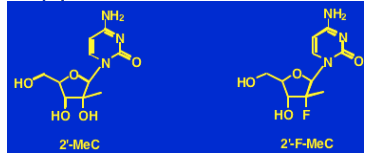
MATERIALS & METHODS
Antiviral agents tested:
-- IFN-a, Intron A (Interferon alfa-2b, recombinant) - Schering Corporation
-- 2'-MeC, NM-107
-- 2'-F-MeC, PSI-6130
Cell culture antiviral assay (HCV Replicon System):
Subgenomic HCV replicon RNA-containing Huh7 cell line (Clone B cells, kindly provided by Dr. Charles M Rice) were maintained in exponential growth in Dulbecco's modified Eagle's medium supplemented with 10% (v/v) heat-inactivated fetal bovine serum, and 500 痢/ml of G418 (Geneticin, GIBCO/Invitrogen). Cells were maintained at 37 degrees C in a humidified 5% CO2 and 95% air atmosphere.
HCV replicon cells were seeded onto 96-well tissue culture plates (5,000 cells/well) in 50 痞 of medium without G418, and 50 痞 of test compounds, alone and in combination, were added at several concentrations in 3-fold dilutions immediately after seeding.
Concentration ranges: IFN-a, 99 to 0.02 IU/ml; 2'-MeC, 0.1 to 33 然; 2'-F-MeC, 0.01 to 33 然. All concentrations were tested in duplicate.
After five days in culture, total cellular RNA was isolated using RNAeasy 96 kit (Qiagen), and both HCV Replicon and endogenous control (TaqMan Ribosomal RNA, Applied Biosystems) were amplified in a single step multiplex real-time PCR assay (7900 HT Sequence Detection System, Applied Biosystems).
HCV replicon and ribosomal RNA amplification
To express the antiviral effectiveness of the drugs, the threshold cycle for HCV amplification of the compounds alone or in combination was subtracted from the average threshold cycle for the no-drug controls (delta Ct-HCV).
The delta Ct-HCV of 3.33 is equivalent 1-log reduction [equal to the 90% effective concentration (EC90)] in HCV replicon RNA levels. The cytotoxicity of the compounds was tested by calculating the delta Ct-rRNA values.
Drug combination analysis
Drug interactions were analyzed using CalcuSyn (Biosoft, Ferguson, MO) computer software. This robust method allows automated simulation of synergism and antagonism at all dose and effect levels, and displays the methods of Chou and Talalay, including dose-effect curve, median effect plot, combination index (CI), isobologram, and the Monte Carlo algorithm plot of Belen'kii & Schinazi (1994).
Since the high degrees of effects are much more therapeutically relevant than the low degrees of effects, the additional weighted average CI of Chou and Talalay (1984) and Chou (2006), which uses the formula: CIwt = [CI50 + 2CI75 + 3CI90 + 4CI95]/10, was determined.
-Belen'kii MS & Schinazi RF Antiviral Res 25:1-11, 1994
-Chou TC & Talalay P 1984 Adv Enz Regul 22:27-55, 1984
-Chou TC, Pharmacol Rev 58:621-681, 2006
RESULTS
The three antiviral compounds (2'-MeC, 2'-F-MeC and IFN-a) tested in the HCV replicon cell-cultured based system inhibited HCV RNA replication in a dose dependent manner and were not cytotoxic (Table 1).
A 90% reduction of HCV replication was observed at 8.0 然 for 2'-MeC, 3.0 然 for 2'-F-MeC, and 26 IU/ml for IFN-a when the drugs were tested alone.
2'-F-MeC was greater than twofold more potent than 2'-MeC.
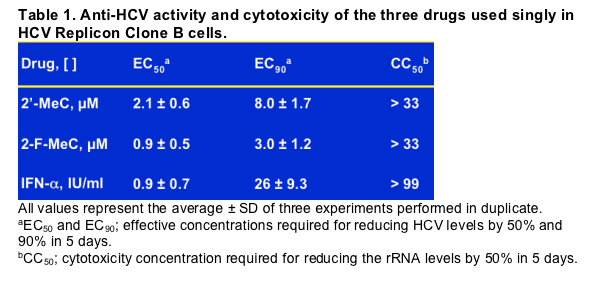
As presented in Table 2, the EC90 values for the combined antiviral activity of 2'-MeC and IFN-a at all ratios ranged from 0.8 to 1.8 然, and the combined activity of 2'-F-MeC and IFN-a ranged from 0.4 to 1.2 然.
--These results indicated that both combinations of either 2'-MeC or 2'-F-MeC with IFN-_ were effective against HCV replication in Clone B cells and enhanced potency over the corresponding monotherapies.
--Overall, the dose-effect relationships for combinations (r = 0.91-0.99) followed the mass-action principle well (Table 2).
--No cytotoxic effects were observed with any of the drugs (or combinations), when tested at the highest concentrations (Table 1 and 2).
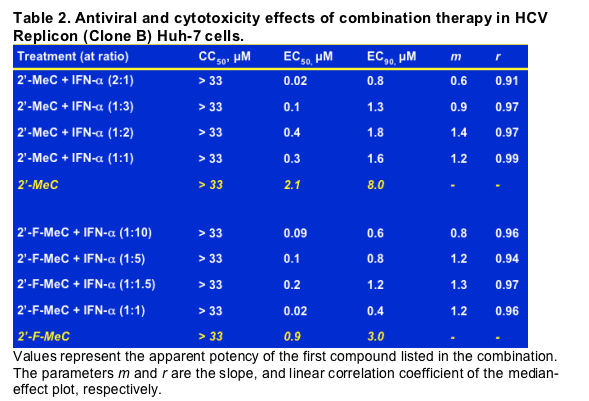
Values represent the apparent potency of the first compound listed in the combination. The parameters m and r are the slope, and linear correlation coefficient of the median-effect plot, respectively.
The data in Table 3 and Figure 1 (A and B), 2 and 3 were analyzed using CalcuSyn (using the Monte Carlo simulation option), where combination index (CI) < 1, = 1, and > 1 indicate synergism, additive effect, and antagonism, respectively.
--Combination of 2'-MeC with IFN-_ at all but the 1:2 ratio showed favorable concentration-reduction (based on EC50 to EC95). The combination of 2'-F-MeC with IFN-_ at ratios of 1:1.5 and 1:1 showed more favorable concentration-reduction than at ratios of 1:10 and 1:5.
--All average CI values were less than 1 for all combination ratios of either 2'-MeC or 2'-F-MeC with IFN-a (Table 3).
--These results indicate that both combinations have synergistic effects on inhibition of HCV RNA replication in the replicon system.
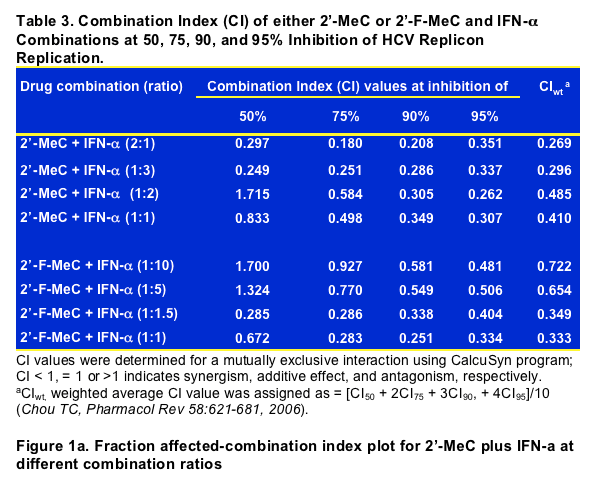
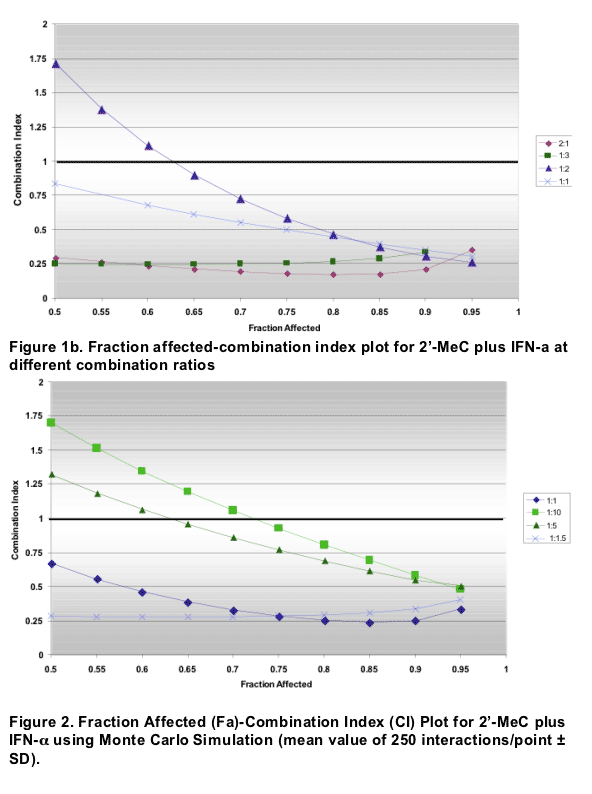
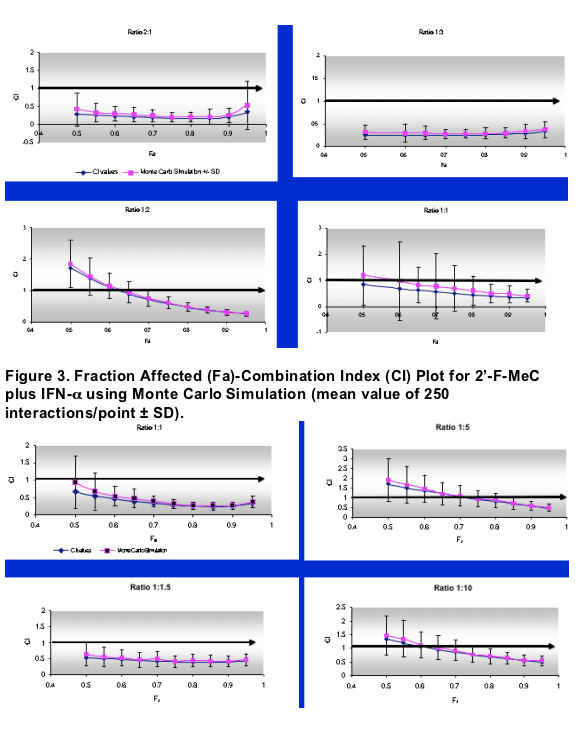
|
| |
|
 |
 |
|
|